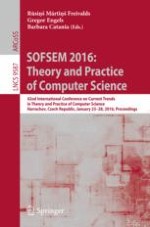2016 | Buch
SOFSEM 2016: Theory and Practice of Computer Science
42nd International Conference on Current Trends in Theory and Practice of Computer Science, Harrachov, Czech Republic, January 23-28, 2016, Proceedings
herausgegeben von: Rūsiņš Mārtiņš Freivalds, Gregor Engels, Barbara Catania
Verlag: Springer Berlin Heidelberg
Buchreihe : Lecture Notes in Computer Science
